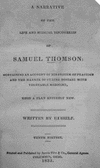The early botanical medical movement as a reflection of life, liberty, and literacy in Jacksonian America
- PMID: 12398251
- PMCID: PMC128961
The early botanical medical movement as a reflection of life, liberty, and literacy in Jacksonian America
Abstract
This paper describes a popular, grassroots health crusade initiated by Samuel Thomson (1769-1843) in the early decades of the nineteenth century and the ways the Thomsonians exemplified the inherent contradictions within the larger context of their own sociopolitical environment. Premised upon a unique brand of frontier egalitarianism exemplified in the Tennessee war-hero Andrew Jackson (1767-1845), the age that bore Jackson's name was ostensibly anti-intellectual, venerating "intuitive wisdom" and "common sense" over book learning and formal education. Likewise, the Thomsonian movement eschewed schooling and science for an empirical embrace of nature's apothecary, a populist rhetoric that belied its own complex and extensive infrastructure of polemical literature. Thus, Thomsonians, in fact, relied upon a literate public to explain and disseminate their system of healing. This paper contributes to the historiography of literacy in the United States that goes beyond typical census-data, probate-record, or will-signature analyses to look at how a popular medical cult was both heir to and promoter of a functionally literate populace.
Figures
References
-
- Ward JW. Andrew Jackson: symbol for an age. New York, NY: Oxford University Press, 1955.
-
- Levine LW. Highbrow/lowbrow: the emergence of cultural hierarchy in America. Cambridge, MA: Harvard University Press, 1988:240.
-
- Allen M. Western rivermen, 1763–1861: Ohio and Mississippi boatmen and the myth of the alligator horse. Baton Rouge, LA: Louisiana State University, 1990:2.
-
- Kerber LK. Diversity and the transformation of American studies. Am Quart. 1989 Sep; 41(3):415–31.
-
- Higham J. The future of American history. J Am Hist. 1994 Mar; 80(4):1297; 1289–309.
Publication types
MeSH terms
Personal name as subject
- Actions
LinkOut - more resources
Full Text Sources



